Oh, Give Me a Home Where the Bison Will Roam
May 15, 2025
By April Pearson
“I guarantee our grandmothers lathered their faces with lard,” says Bethany Kriegel. The co-owner of Sunset Hills Bison Ranch in Malcom has a delightful outlook on the many benefits of raising bison in Iowa. The business sells delicious and nutritious bison burgers, brats, steaks and sausage, as well as T-shirts, stuffed animals and whipped tallow — rendered bison fat that’s ultra-moisturizing. “I used to buy it from another company out of Canada, but then I just started making my own because it's really good for skincare.”
Beyond providing bison products, the Kriegels appreciate the relationship bison have with the land, the holistic experience of raising the animals in nature, the uniquely supportive bison-producer community and the opportunity to connect Iowans with their rural roots.
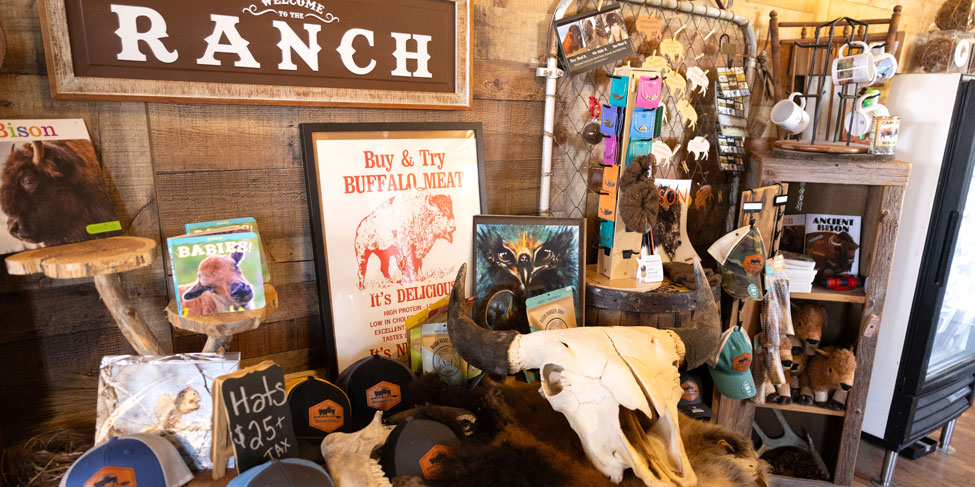 A Wild Idea
A Wild Idea
Bethany’s husband Karl grew up farming and raising livestock with his dad and brother, and now he has a custom application business for other farmers. Spring, summer and fall are busy, but in the winter? “Wintertime, we’d get super bored,” says Bethany. “We had traveled out West to Yellowstone and fell in love with the bison out there, so looking out the window in 2018, I just said, ‘Wouldn't it be fun to have bison?’ and my husband actually agreed.”
Since the couple thought Karl’s experience raising beef cattle would be similar to raising bison, they planned to buy their first herd that spring. “Once we started researching them, we found out that raising the largest land mammal in North America on a whim is not a good idea,” she says. Instead, they spent 2019 visiting different bison farms to learn everything they needed to know.
“One thing we quickly realized was that bison producers are very supportive. They just want more bison producers,” says Bethany. “The first one we met with had all her financials laid out, and we were like, ‘We're row crop farmers…we don't typically show people our cards.’ It was very refreshing and proved that this industry is definitely for us.”
Although skeptical at first, Karl’s parents agreed to provide the land in exchange for a share in the operation, and in 2020, the couple purchased their starter herd.
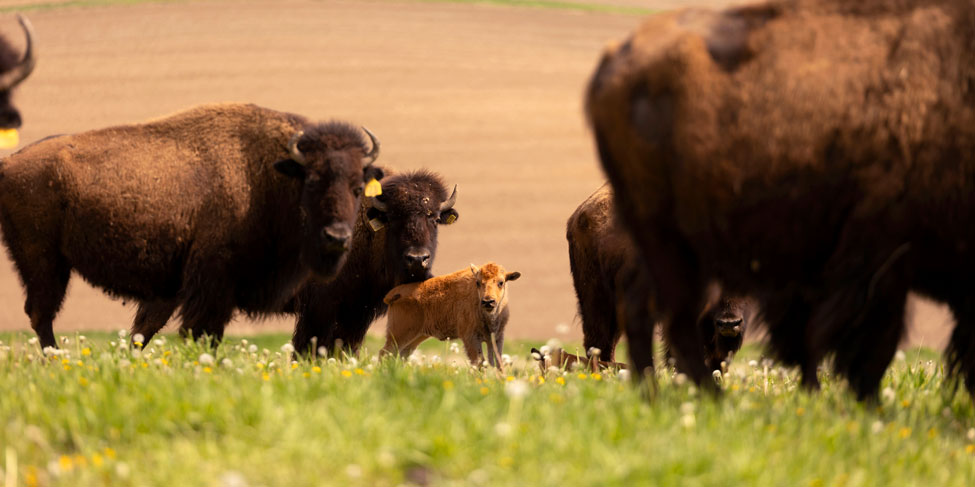 Raising Roamers
Raising Roamers
Sunset Hill started with eight animals from Tama, Iowa. Now they’re sitting comfortably with 23 cows and two breeding bulls, and they’re expecting 23 calves this spring and summer. Calving season typically occurs from April to June, followed by the rut from July to September. Bison can produce a calf every year, starting at 2 years old and going into their twenties, so the rate of return on one head of bison is advantageous.
The bison graze on a native grass blend in three 16-acre paddocks, rotating every one to two weeks. With its nutrient-rich soil, long growing season and acres of prairie, Iowa is an ideal environment for bison to thrive. “Bison don’t want or need any type of covering. They don't need a lot of trees. They don't need a barn. They make their way during the winter season,” says Bethany. “Ours are very spoiled — they get fresh hay in the winter and their icy water broken up, but if they didn't have those things, they would be fine. When it's negative thirties here, we're not worried about them.”
The Kriegels raise low-stress bison because happy bison are tastier bison. “We try to do low-stress handling, and we only handle them once a year,” she says. “Even moving them from pasture to pasture, we kind of train them to do what they already want to do. We don't do any type of hazing or trying to get them to move in a direction they simply don't want to.”
Like cattle, bison are best processed at 18-24 months, though they can be much older. Sunset Hills processes only six animals a year at Dayton’s Meat Locker and Elma Meat Locker in Iowa. “We’re part of the Choose Iowa program, which means our meat is raised and produced here in Iowa,” says Bethany. Bison has lower fat content and finer marbling, which is why bison meat is lean and tender. Most of the Kreigels’ customers are locals, but they do have travelers who stay at their lodging and request bison meat.
Lodging, you say?
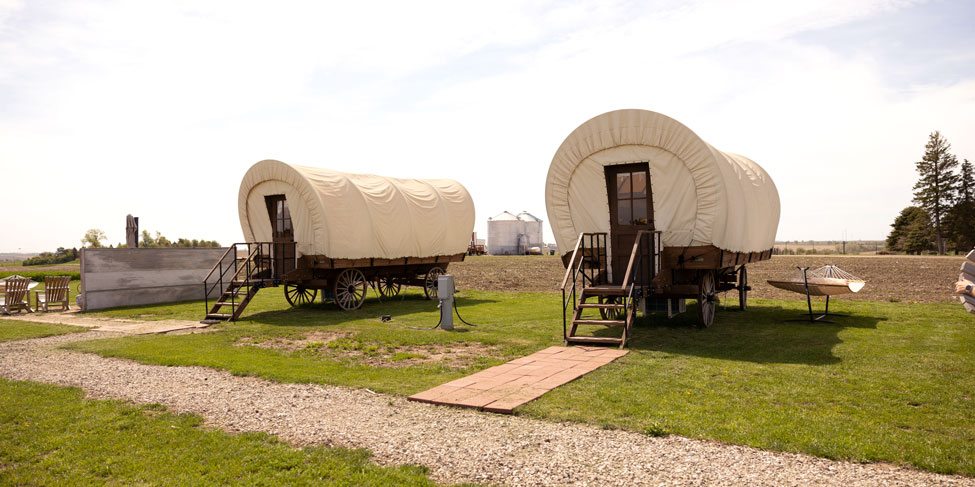 Game for Glamping
Game for Glamping
Bethany has a hospitality background, having worked for Marriott for over a decade. She knew that people would pay to experience the beauty of nature and waking up to bison in the yard. “Again, my in-laws were like, ‘Yeah, that would be great, but who would want to vacation in rural Iowa?’ Thankfully, my husband usually goes along with my crazy ideas and was willing to try it,” she says.
In 2021, they brought in a cabin for visitors to rent, complete with a small kitchen, bathroom, bed loft and wood-burning stove. “It’s open year-round, so in the winter, it just creates this magical little setup where you can have your coffee while watching the bison in your cozy little cabin,” says Bethany.
After that, they bought three wagons to create a “glamping” experience, where visitors can enjoy all the amenities of home while taking in the bison herd against the backdrop that gave Sunset Hills its name. “My mother-in-law came up with it,” she says. “We have these rolling hills — it's exactly what you think of when you hear about Iowa farms. And then we get these incredible sunsets. It doesn't matter if the weather is terrible or gorgeous; we always get a beautiful sunset over the rolling hills.”
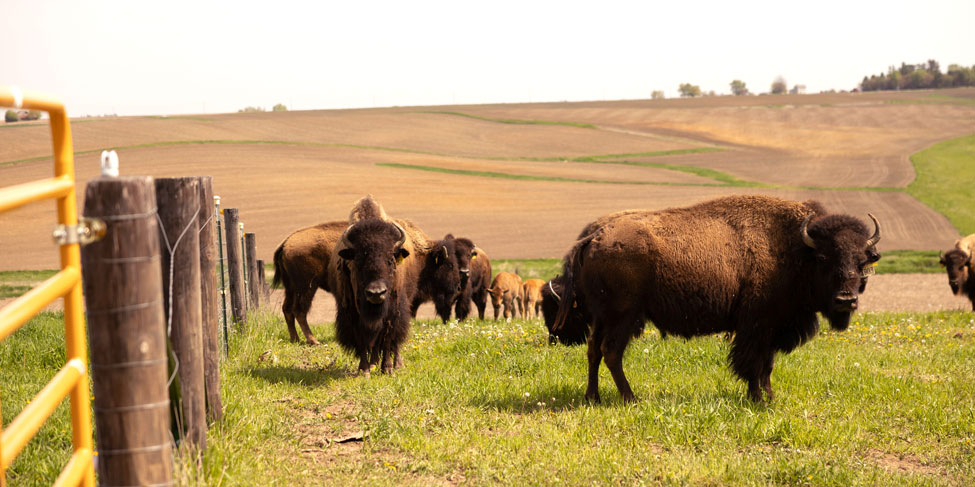 Nurturing the Herd
Nurturing the Herd
From little league sponsorships to hospitality packages to auction items, Sunset Hills tries to give back financially and in-kind to those who support them. They also offer tours to schools, community organizations and care centers. “I love it when nursing home groups come out,” says Bethany. “I usually jump on their bus, and then we drive around the bison herd with the residents. Some of the old farmers are like, ‘Wow, look at that tractor!’ and I’m like, “Yeah, but look! The bison are calving!” and they just want to see the equipment. It’s my favorite.”
The Kriegels also host a National Bison Day event every year, which involves a vendor fair, grilled bison burgers and a pumpkin dump — an opportunity for community members to feed their old pumpkins to the bison herd. “It keeps those pumpkins off the streets after Halloween,” she says. Parking is just five bucks, and admission is free. “If you have a large family, load them up and bring them out for the day. They get to see the bison herd and just have a good time.”
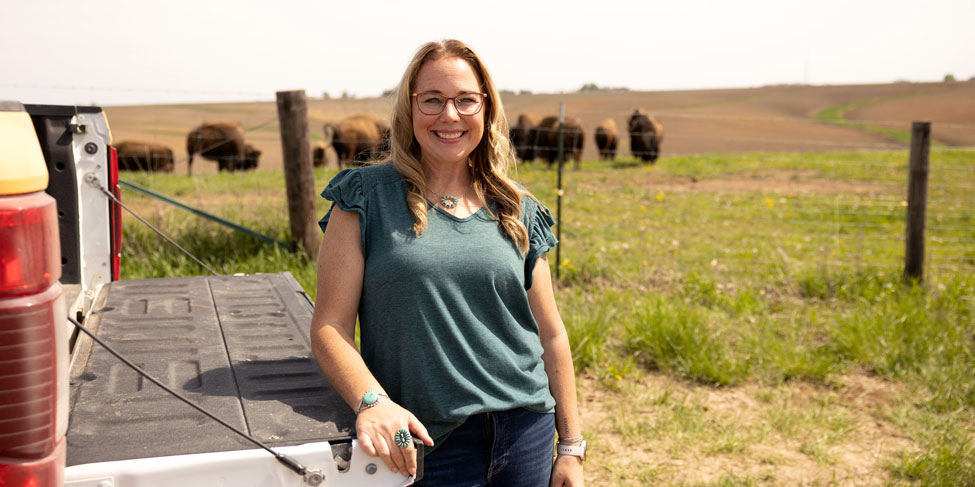 “Bison have been known to improve the ecosystem around them, complete with plants, animals and pollinators. They're intelligent, they're athletic, and they help reset the land.” — Bethany Kriegel
“Bison have been known to improve the ecosystem around them, complete with plants, animals and pollinators. They're intelligent, they're athletic, and they help reset the land.” — Bethany Kriegel
Bringing Bison Back From the Brink
Native to North America, American bison once covered the Great Plains and were vital to the survival of Indigenous communities. In the late 1800s, bison faced near extinction due to overhunting, westward expansion and government policies designed to thwart Indigenous tribes. The “Great Slaughter” brought the bison population down from between 30 million and 60 million to just a few hundred. Thanks to producers like the Kriegels, there are now about 500,000 bison in the U.S.